Heinrich J.G., Aldinger F. (Eds.) Ceramic Materials and Components for Engines
Подождите немного. Документ загружается.

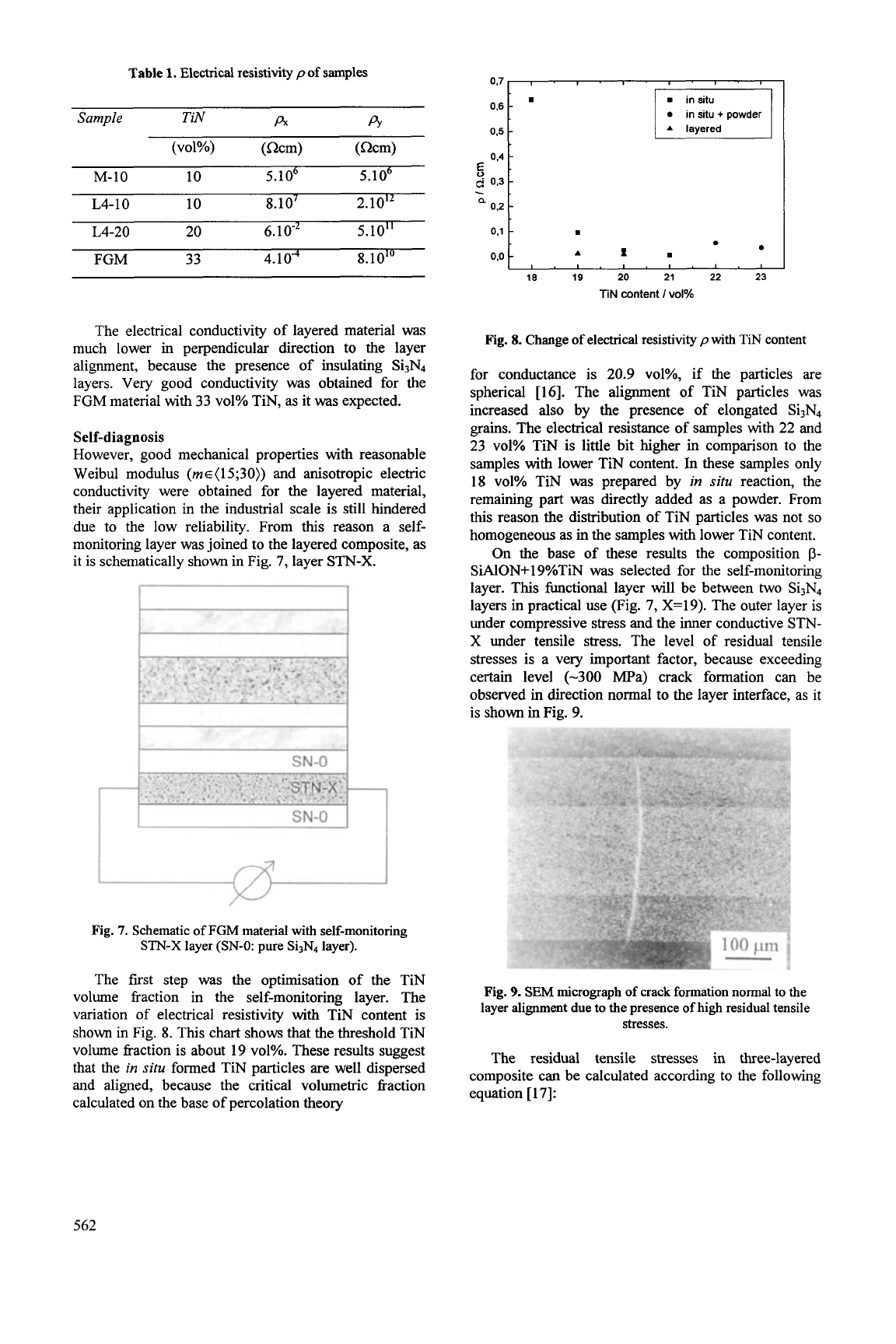
Table
1.
Electrical resistivity
p
of samples
Sample
TiN
Px
A
M-10
10
5.106 5.10'
L4-10
10 8. lo' 2.1012
FGM
33 4.1
O4
8.1
O'O
L4-20 20 6.1
0-2
5.10"
The electrical conductivity of layered material
was
much lower in perpendicular direction to the layer
alignment, because the presence of insulating Si3N4
layers. Very good conductivity was obtained for the
FGM material with
33
vol% TiN, as it
was
expected.
Self-diagnosis
However, good mechanical properties with reasonable
Weibul modulus (m~(15;30)) and anisotropic electric
conductivity were obtained for the layered material,
their application in the industrial scale is still hindered
due to the low reliability. From
this
reason a self-
monitoring layer was joined to the layered composite, as
it is schematically
shown
in Fig.
7,
layer
STN-X.
I
SN-0
1
I
I
SN-0
1
I
Fig.
7.
Schematic
of
FGM
material with self-monitoring
STN-X
layer (SN-0: pure Si3N4 layer).
The first step
was
the optimisation of the TiN
volume fraction in the self-monitoring layer. The
variation of electrical resistivity with TiN content
is
shown in Fig.
8.
This chart shows that the threshold TiN
volume fraction is about 19 ~01%. These results suggest
that the
in
situ
formed TiN particles are well dispersed
and aligned, because the critical volumetric fiaction
calculated on the base of percolation theory
0.5
in
situ
+
powder
1
:
::3
1
0.0
t
a
a
A
I
10
19
20
21
22
23
TiN
content
I
vol%
Fig.
8.
Change of electrical resistivity
p
with
TiN content
for conductance is 20.9 vol%, if the particles are
spherical
[16].
The alignment of TiN particles was
increased also by the presence of elongated Si3N4
grains. The electrical resistance of samples with 22 and
23 vol% TiN is little bit higher
in
comparison to the
samples with lower TiN content.
In
these samples only
18 vol% TiN
was
prepared by
in
situ
reaction, the
remaining part was directly added as a powder. From
this reason the distribution of TiN particles was not
so
homogeneous
as
in the samples with lower TiN content.
On
the base of these results the composition
p-
SiAlON+19%TiN
was
selected for the self-monitoring
layer. This functional layer will be between two Si3N4
layers in practical use (Fig.
7,
X=19). The outer layer is
under compressive stress and the inner conductive
STN-
X under tensile stress. The level of residual tensile
stresses is a very important factor, because exceeding
certain level
(-300
IvlPa) crack formation can be
observed in direction normal to the layer interface, as
it
is shown in Fig. 9.
Fig.
9.
SEM
micrograph
of
crack formation normal to the
layer alignment due to the presence
of
high residual tensile
stresses.
The residual tensile stresses in three-layered
composite can be calculated according to the following
equation
[
171:
562
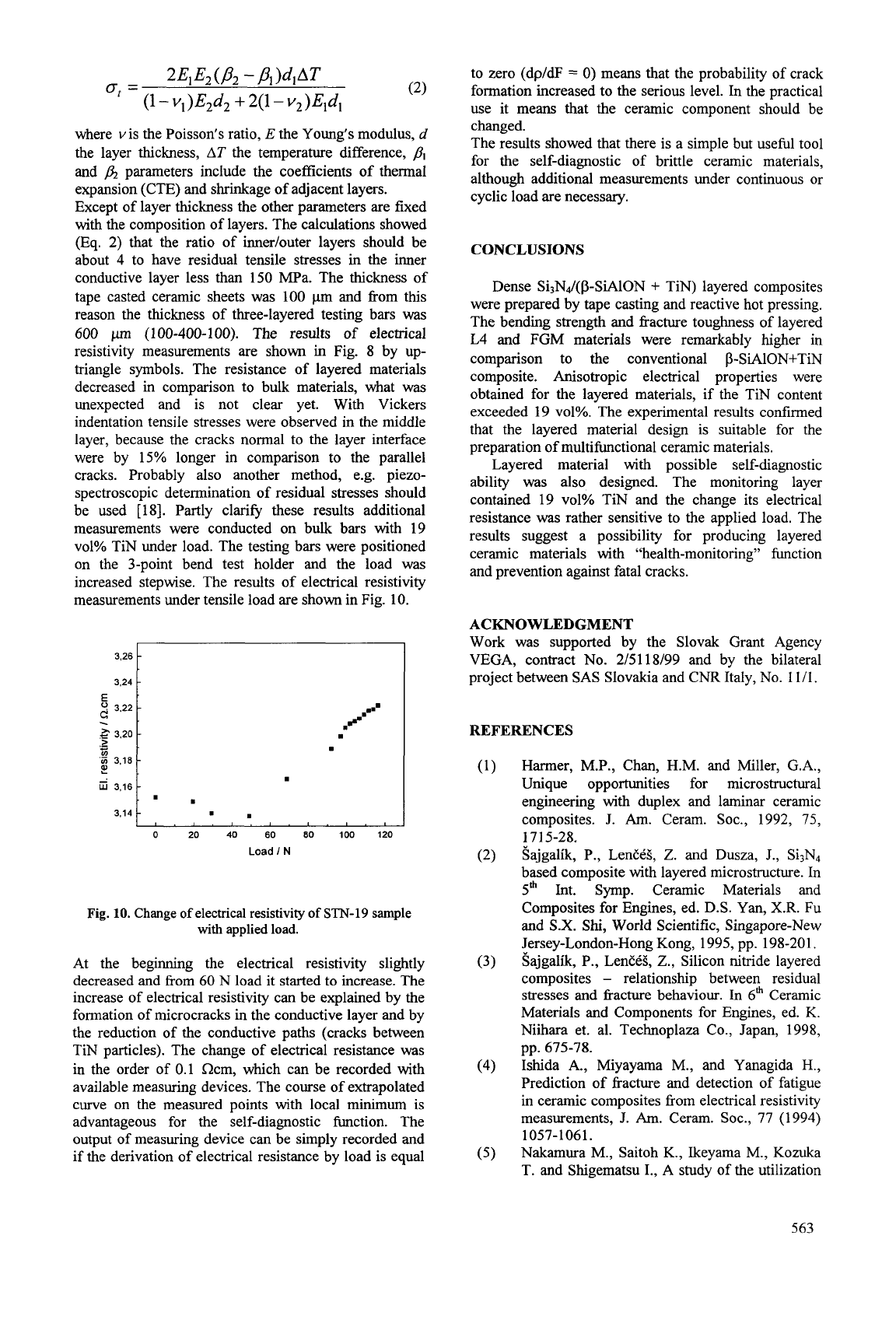
where
v
is the Poisson’s ratio,
E
the Young’s modulus,
d
the layer thickness,
AT
the temperature difference,
/?,
and
fi
parameters include the coefficients
of
thermal
expansion (CTE) and shrinkage of adjacent layers.
Except of layer thickness the other parameters are fixed
with the composition of layers. The calculations showed
(Eq. 2) that the ratio of innerlouter layers should be
about 4 to have residual tensile stresses in the inner
conductive layer less than 150 MPa. The thickness of
tape casted ceramic sheets was
100
pm
and fiom
this
reason the thickness of three-layered testing bars
was
600
pm (100-400-100). The results
of
electrical
resistivity measurements are shown
in
Fig.
8
by up-
triangle symbols. The resistance of layered materials
decreased in comparison to bulk materials, what was
unexpected and is not clear yet. With Vickers
indentation tensile stresses were observed in the middle
layer, because the cracks normal to the layer interface
were by 15% longer in comparison to the parallel
cracks. Probably also another method, e.g. piezo-
spectroscopic determination
of
residual stresses should
be used [18]. Partly clarify these results additional
measurements were conducted on bulk bars with 19
vol% TiN under load. The testing bars were positioned
on the 3-point bend test holder and the load was
increased stepwise. The results of electrical resistivity
measurements under tensile load are shown in Fig. 10.
c
3.24
3,26--1
‘9
3.18
3.16
8.
.818
8
8
8
3.14
1.
0
20
40
60
80
100
120
Load
I
N
Fig.
10.
Change
of
electrical resistivity
of
STN-19
sample
with
applied load.
At the beginning the electrical resistivity slightly
decreased and fiom
60
N load it started to increase. The
increase of electrical resistivity can be explained by the
formation of microcracks in the conductive layer and by
the reduction of the conductive paths (cracks between
TiN particles). The change
of
electrical resistance was
in the order of 0.1 Qcm, which can be recorded with
available measuring devices. The course of extrapolated
curve on the measured points with local minimum is
advantageous for the self-diagnostic function. The
output of measuring device can be simply recorded and
if the derivation of electrical resistance by load is equal
to zero (dp/dF
=
0)
means that the probability of crack
formation increased to the serious level. In the practical
use it means that the ceramic component should be
changed.
The results showed that there is a simple but useful tool
for the self-diagnostic of brittle ceramic materials,
although additional measurements under continuous or
cyclic load are necessary.
CONCLUSIONS
Dense Si3NJ(p-SiA10N
+
TiN) layered composites
were prepared by tape casting and reactive hot pressing.
The bending strength and fracture toughness of layered
L4
and FGM materials were remarkably higher in
comparison to the conventional P-SiAlON+TiN
composite. Anisotropic electrical properties were
obtained for the layered materials, if the TiN content
exceeded 19 ~01%. The experimental results confirmed
that the layered material design
is
suitable for the
preparation
of
multifunctional ceramic materials.
Layered material with possible self-diagnostic
ability was also designed. The monitoring layer
contained 19 vol% TiN and the change its electrical
resistance
was
rather sensitive to the applied load. The
results suggest a possibility for producing layered
ceramic materials with “health-monitoring” function
and prevention against fatal cracks.
ACKNOWLEDGMENT
Work was supported by the Slovak Grant Agency
VEGA, contract No. 2/5118/99 and by the bilateral
project between SAS Slovakia and CNR Italy, No.
1
1/1.
REFERENCES
Harmer, M.P., Chan,
H.M.
and Miller, G.A.,
Unique opportunities for microstructural
engineering with duplex and laminar ceramic
composites. J.
Am.
Ceram. SOC., 1992,
75,
Sajgalik, P., LenWS,
Z.
and Dusza,
J.,
Si;N,
based composite with layered microstructure. In
5’
Int. Symp. Ceramic Materials and
Composites for Engines, ed. D.S. Yan,
X.R.
Fu
and
S.X.
Shi,
World Scientific, Singapore-New
Jersey-London-Hong Kong, 1995, pp. 198-20 1.
Sajgalik, P., LenECS,
Z.,
Silicon nitride layered
composites
-
relationship between residual
stresses and fiacture behaviour. In 6‘h Ceramic
Materials and Components for Engines, ed. K.
Niihara et. al. Technoplaza Co., Japan, 1998,
Ishida A., Miyayama M., and Yanagida
H.,
Prediction of fracture and detection of fatigue
in ceramic composites fiom electrical resistivity
measurements,
J.
Am.
Ceram. SOC.,
77
(1994)
Nakamura M., Saitoh K., Ikeyama M., Kozuka
T. and Shigematsu
I.,
A study of the utilization
171
5-28.
pp. 675-78.
1057-1 061.
563
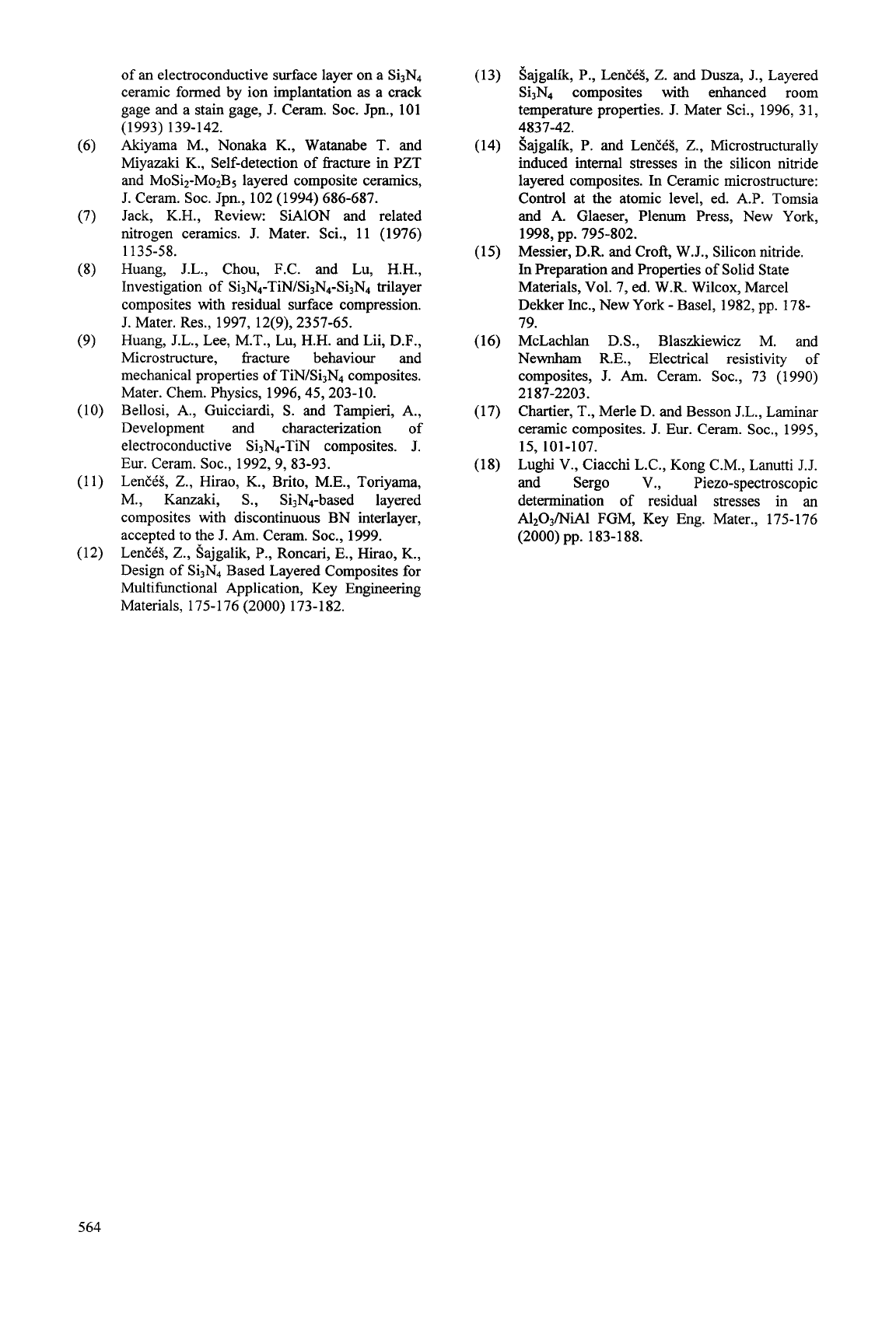
of
an electroconductive surface layer on a Si3N4
ceramic formed by ion implantation as a crack
gage and a stain gage, J. Ceram.
SOC.
Jpn., 101
Akiyama M., Nonaka K., Watanabe T. and
Miyazaki K., Self-detection of fi-acture in PZT
and MoSi2-Mo2B5 layered composite ceramics,
J. Ceram. SOC. Jpn., 102 (1994) 686-687.
(7) Jack, K.H., Review: SiAlON and related
nitrogen ceramics. J. Mater. Sci., 11 (1976)
(8) Huang, J.L., Chou, F.C. and Lu, H.H.,
Investigation of Si3N4-TiN/Si3N4-Si3N4 trilayer
composites with residual surface compression.
J. Mater. Res., 1997, 12(9), 2357-65.
Huang, J.L., Lee, M.T., Lu, H.H. and Lii, D.F.,
Microstructure, fi-acture behaviour and
mechanical properties
of
TiN/Si3N4 composites.
Mater. Chem. Physics, 1996,45,203-10.
Bellosi, A., Guicciardi,
S.
and Tampieri, A.,
Development and characterization
of
electroconductive Si3N4-TiN composites. J.
Eur.
Ceram. SOC., 1992,9,83-93.
LenECS, Z., Hirao, K., Brito, M.E., Toriyama,
M., Kanzaki,
S.,
Si3N4-based layered
composites with discontinuous BN interlayer,
accepted to the J.
Am.
Ceram. SOC., 1999.
LenECS,
Z.,
Sajgalik, P., Roncari, E., Hirao, K.,
Design of Si3N4 Based Layered Composites for
Multifimctional Application, Key Engineering
Materials, 175-176 (2000) 173-182.
(1993) 139-142.
(6)
1135-58.
(9)
(10)
(11)
(12)
(13)
Sajgalik, P., LenteS,
Z.
and Dusza, J., Layered
Si3N4 composites with enhanced room
temperature properties. J. Mater Sci., 1996, 3 1,
Sajgalik, P. and Len&%, Z., Microstructurally
induced internal stresses in the silicon nitride
layered composites. In Ceramic microstructure:
Control at the atomic level, ed. A.P. Tomsia
and A. Glaeser, Plenum Press, New York,
Messier, D.R. and Croft, W.J., Silicon nitride.
In
Preparation and Properties
of
Solid State
Materials, Vol. 7, ed. W.R. Wilcox, Marcel
Dekker Inc., New York
-
Basel, 1982, pp. 178-
79.
(16) McLachlan D.S., Blaszkiewicz M. and
Newnham R.E., Electrical resistivity of
composites, J.
Am.
Ceram. SOC., 73 (1990)
Chartier, T., Merle D. and Besson J.L., Laminar
ceramic composites. J. Eur. Ceram. SOC., 1995,
Lughi V., Ciacchi L.C., Kong C.M., Lanutti J. J.
and Sergo V., Piezo-spectroscopic
determination of residual stresses in an
Al203/NiAl FGM, Key Eng. Mater., 175-176
4837-42.
(14)
1998, pp. 795-802.
(15)
21 87-2203.
(17)
15, 101-107.
(1 8)
(2000) pp. 183-1 88.
564
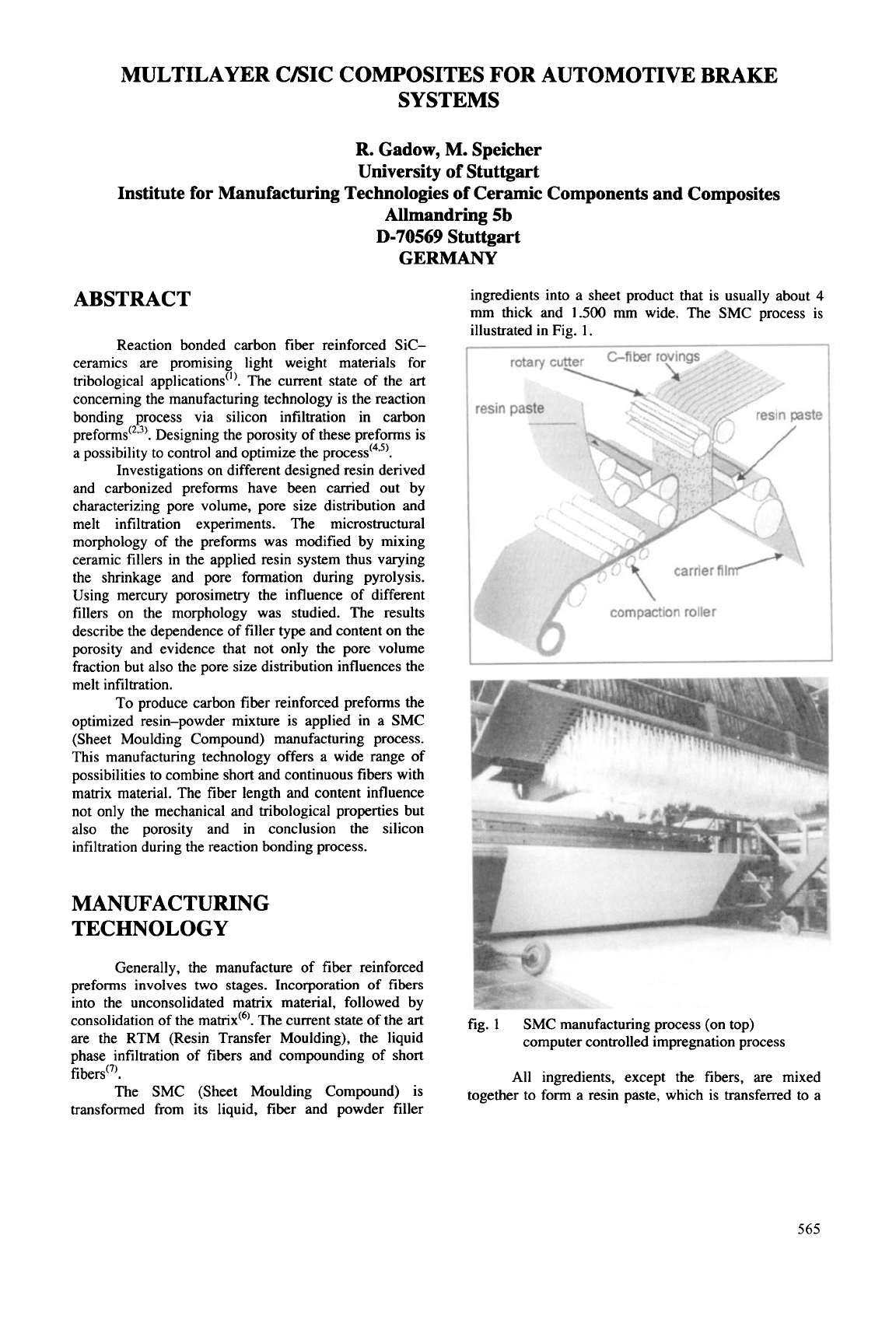
MULTILAYER CBIC COMPOSITES FOR AUTOMOTIVE BRAKE
SYSTEMS
R.
Gadow, M. Speicher
University of Stuttgart
Institute for Manufacturing Technologies
of
Ceramic Components and Composites
Allmandring
5b
D-70569
Stuttgart
GERMANY
ABSTRACT
Reaction bonded carbon fiber reinforced Sic-
ceramics are promising light weight materials for
tribological applications('). The current state of the
art
concerning the manufacturing technology is the reaction
bonding process via silicon infiltration in carbon
preforms'233'. Designing the porosity of these preforms is
a possibility to control and optimize the
Investigations
on
different designed resin derived
and carbonized preforms have been carried out by
characterizing pore volume, pore size distribution and
melt infiltration experiments. The microstructural
morphology of the preforms was modified by mixing
ceramic fillers
in
the applied resin system thus varying
the shrinkage and pore formation during pyrolysis.
Using mercury porosimetry the influence of different
fillers
on
the morphology was studied. The results
describe the dependence of filler type and content on the
porosity and evidence that not only the pore volume
fraction but also the pore size distribution influences the
melt infiltration.
To produce carbon fiber reinforced preforms the
optimized resin-powder mixture is applied in a SMC
(Sheet Moulding Compound) manufacturing process.
This manufacturing technology offers a wide range of
possibilities to combine short and continuous fibers with
matrix material. The fiber length and content influence
not only the mechanical and tribological properties but
also the porosity and in conclusion the silicon
infiltration during the reaction bonding process.
MANUFACTURING
TECHNOLOGY
Generally, the manufacture of fiber reinforced
preforms involves two stages. Incorporation
of
fibers
into the unconsolidated matrix material, followed by
consolidation of the matrix'@. The current state of the
art
are the RTM (Resin Transfer Moulding), the liquid
phase infiltration of fibers and compounding of short
fibers"'.
The SMC (Sheet Moulding Compound) is
transformed from its liquid, fiber and powder filler
ingredients into a sheet product that
is
usually about
4
mm thick and
1.500
mm wide. The SMC process is
illustrated in Fig.
1.
fig.
1
SMC manufacturing process (on top)
computer controlled impregnation process
All
ingredients, except the fibers, are mixed
together to form a resin paste, which is transferred to a
565
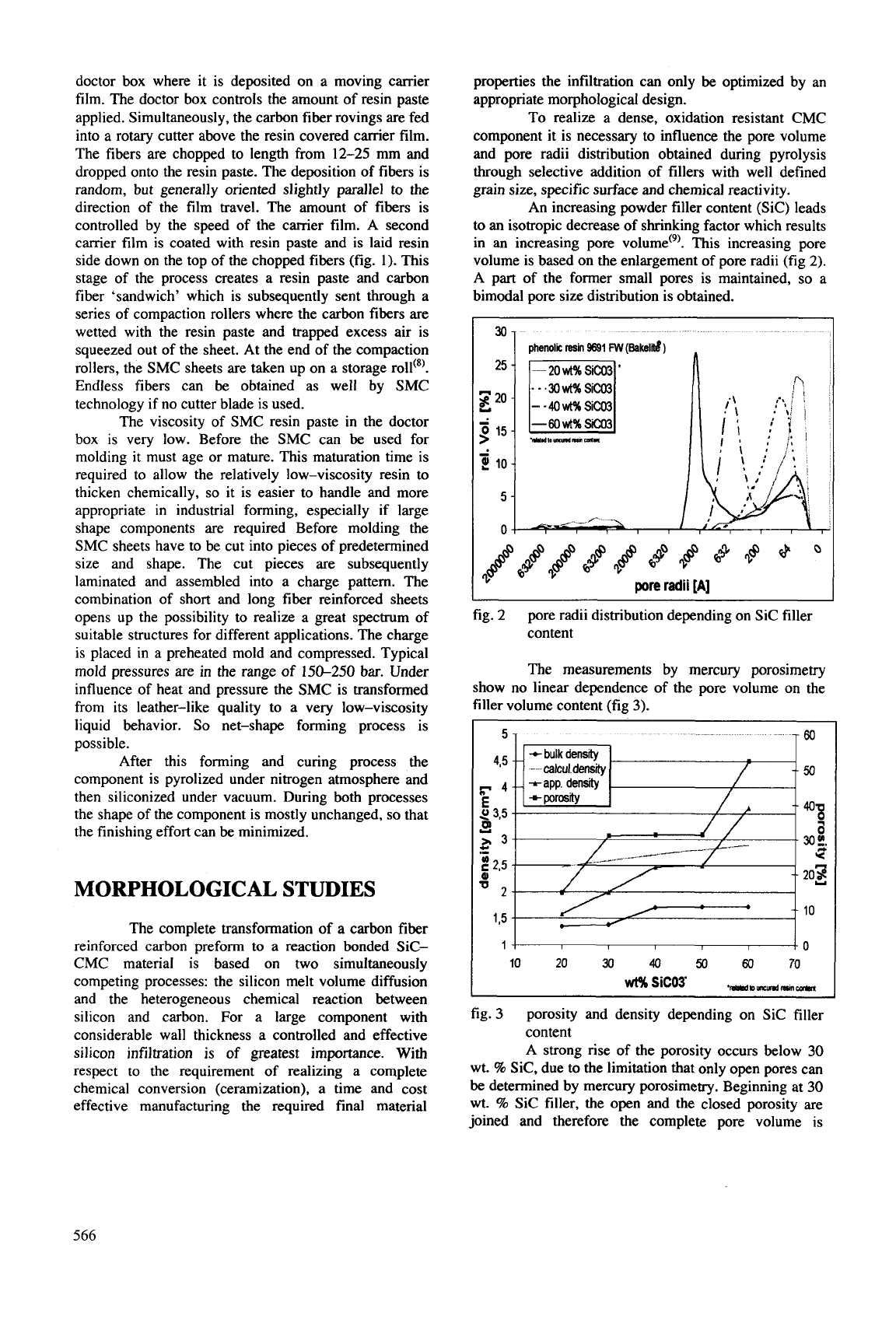
doctor box where
it
is deposited on a moving carrier
film. The doctor box controls the amount of resin paste
applied. Simultaneously, the carbon fiber rovings
are
fed
into a rotary cutter above the resin covered carrier film.
The fibers are chopped to length from
12-25
mm and
dropped onto the resin paste. The deposition
of
fibers is
random, but generally oriented slightly parallel to the
direction of the film travel. The amount of fibers is
controlled by the speed of the carrier film. A second
carrier film is coated with resin paste and is laid resin
side down on the top of the chopped fibers (fig.
1).
This
stage of the process creates a resin paste and carbon
fiber 'sandwich' which is subsequently sent through a
series of compaction rollers where the carbon fibers are
wetted with the resin paste and trapped excess air is
squeezed out of the sheet. At the end of the compaction
rollers, the SMC sheets are taken up on a storage
roll(*).
Endless fibers can
be.
obtained as well by SMC
technology
if
no cutter blade is used.
The viscosity of SMC resin paste in the doctor
box is very low. Before the SMC can
be
used for
molding it must age
or
mature. This maturation time is
required to allow the relatively low-viscosity resin to
thicken chemically,
so
it is easier to handle and more
appropriate
in
industrial forming, especially if large
shape components are required Before molding the
SMC sheets have to be cut into pieces of predetermined
size and shape. The cut pieces are subsequently
laminated and assembled into a charge pattern. The
combination of short and long fiber reinforced sheets
opens up the possibility to realize a great spectrum of
suitable structures for different applications. The charge
is placed
in
a preheated mold and compressed. Typical
mold pressures are
in
the range of
150-250
bar. Under
influence of heat and pressure the SMC is transformed
from its leather-like quality to a very low-viscosity
liquid behavior.
So
net-shape forming process is
possible.
After this forming and curing process the
component is pyrolized under nitrogen atmosphere and
then siliconized under vacuum. During both processes
the shape of the component is mostly unchanged,
so
that
the finishing effort can
be
minimized.
MORPHOLOGICAL STUDIES
The complete transformation of a carbon fiber
reinforced carbon preform to a reaction bonded SiC-
CMC material is based on two simultaneously
competing processes: the silicon melt volume diffusion
and the heterogeneous chemical reaction between
silicon and carbon.
For
a large component with
considerable wall thickness a controlled and effective
silicon infiltration is of greatest importance. With
respect to the requirement of realizing a complete
chemical conversion (ceramization), a time and cost
effective manufacturing the required final material
properties the infiltration can only
be
optimized by an
appropriate morphological design.
To realize a dense, oxidation resistant CMC
component it is necessary to influence the pore volume
and pore radii distribution obtained during pyrolysis
through selective addition of fillers with well defined
grain size, specific surface and chemical reactivity.
An increasing powder filler content (Sic) leads
to
an
isotropic decrease of shrinking factor which results
in an increasing pore volume('). This increasing pore
volume is based on the enlargement of pore radii (fig
2).
A part of the former small pores is maintained, so a
bimodal pore size distribution is obtained.
30
25
z
20
15
phenolc
resin
9691
MI
(Bakeld)
--4Owt%Sic03
I'
I
,t
fig.
2
pore radii distribution depending on Sic filler
content
The measurements by mercury porosimetry
show no linear dependence of the pore volume on the
filler volume content (fig
3).
-c
bulk
density
+-
app.
density
---
calcul.density
50
40a
a
30
00.
u"
20z
70
10
20
30
40
50
fig.3 porosity and density depending on Sic filler
content
A strong rise of the porosity occurs below
30
wt. % Sic, due to the limitation that only open pores can
be
determined by mercury porosimetry. Beginning at 30
wt.
%
Sic filler, the open and the closed porosity are
joined and therefore the complete pore volume is
566
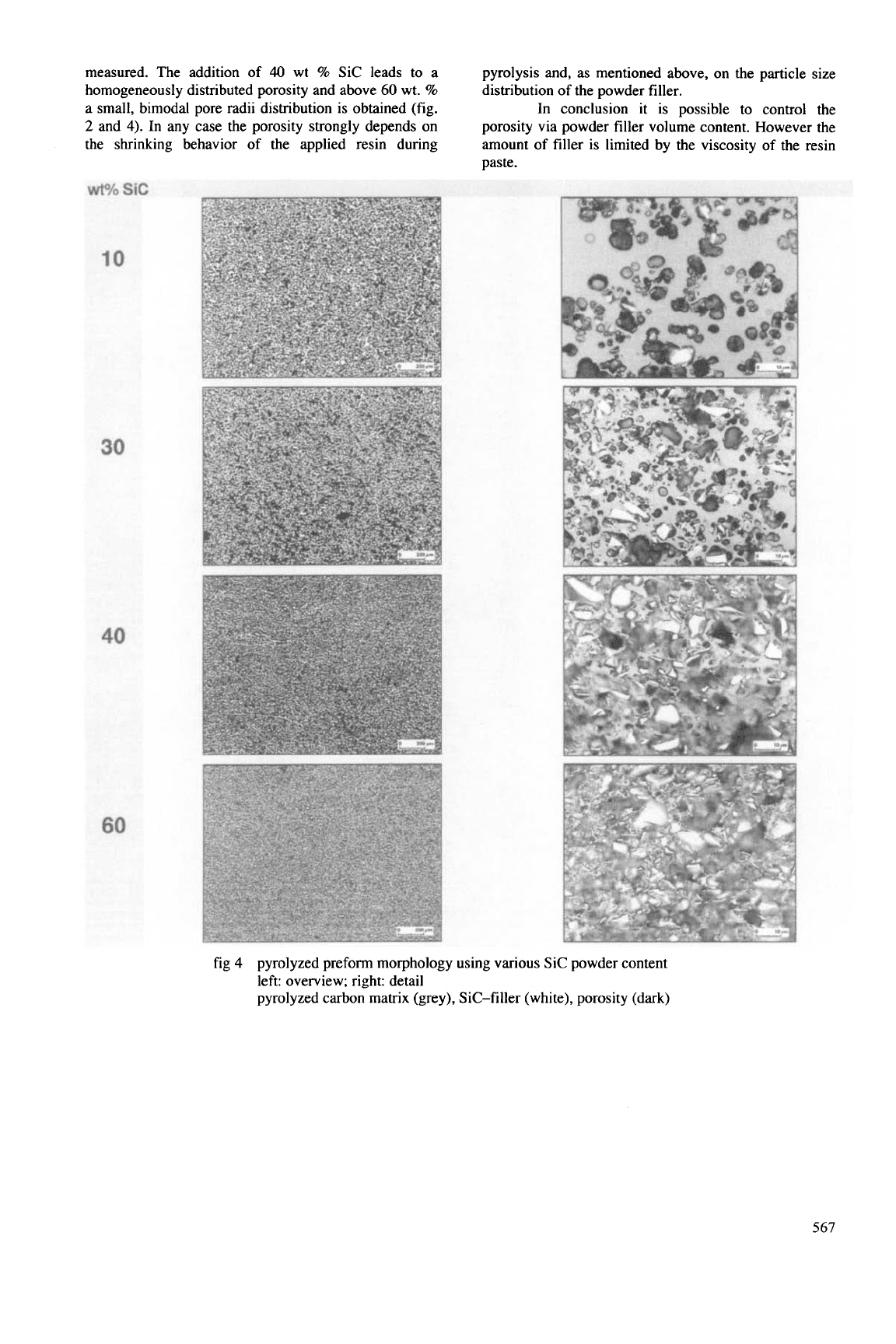
measured. The addition of
40
wt
%
Sic leads to a
homogeneously distributed porosity and above
60
wt.
%
a
small, bimodal pore radii distribution is obtained (fig.
2
and
4).
In any case the porosity strongly depends on
the shrinking behavior of the applied resin during
pyrolysis and, as mentioned above, on the particle size
distribution of the powder filler.
In conclusion it is possible to control the
porosity via powder filler volume content. However the
amount of filler is limited by the viscosity of the resin
paste.
wwo
sic
10
fig
4
pyrolyzed preform morphology using various Sic powder content
left: overview; right: detail
pyrolyzed carbon matrix (grey), Sic-filler (white), porosity (dark)
567
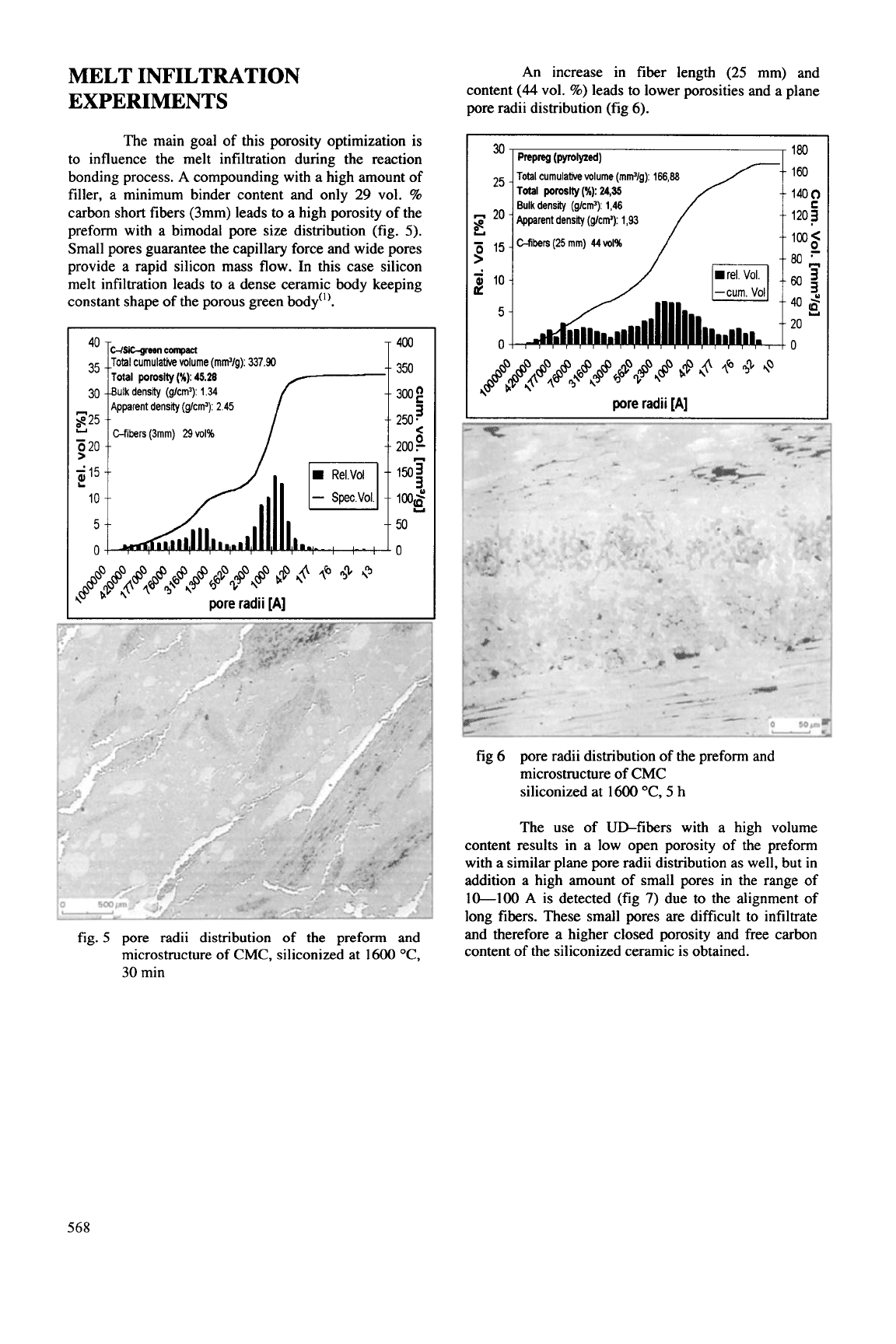
MELT INFILTRATION
EXPERIMENTS
An increase in fiber length (25 mm) and
content
(44
vol.
%)
leads to lower porosities and a plane
pore radii distribution (fig
6).
The main goal of this porosity optimization is
to influence the melt infiltration during the reaction
bonding process.
A
compounding with a high amount of
filler, a minimum binder content and only 29 vol.
%
carbon short fibers (3mm) leads to a high porosity of the
preform with a bimodal
pore
size distribution (fig.
5).
Small pores guarantee the capillary force and wide pores
provide a rapid silicon mass
flow.
In this case silicon
melt infiltration leads to a dense ceramic body keeping
constant shape
of
the porous green body"'.
J
Gfiben(3mm)
29~01%
-
Spec.Vol.
4M3
350
300
2
3
250
;
0
200
7
150
-
IOOg.
u
50
0
0
0
0@@@
0
0
0
8
86,
&I
9
6%
9
8
b#'?
26
%'
"
804%
4
4
+J
,@
8
4
pore radii [A]
fig.
5
pore radii distribution
of
the
preform and
microstructure of CMC, siliconized at
1600
"C,
30
min
30
25
n
20
*
Total
cumulative volume (mnP/g):
166,88
Total
porosity
(X):
24,s
Bulk
density (glcw):
i,46
Apparent density (g/cnP):
1,93
180
160
140
0
120
5
/
I
15
1
C-fiben
(25
mm)
44
~01%
i
10-
a
5-
0-
I.
pore radii [A]
fig
6
pore radii distribution of the preform and
microstructure of CMC
siliconized at
1600
"C, 5 h
The use of UD-fibers with a high volume
content results in a
low
open porosity of the preform
with a similar plane pore radii distribution as well, but
in
addition a high amount of small pores
in
the range of
10-100
A
is detected (fig
7)
due to the alignment of
long fibers. These small pores are difficult to infiltrate
and therefore a higher closed porosity and free carbon
content of the siliconized ceramic is obtained.
568
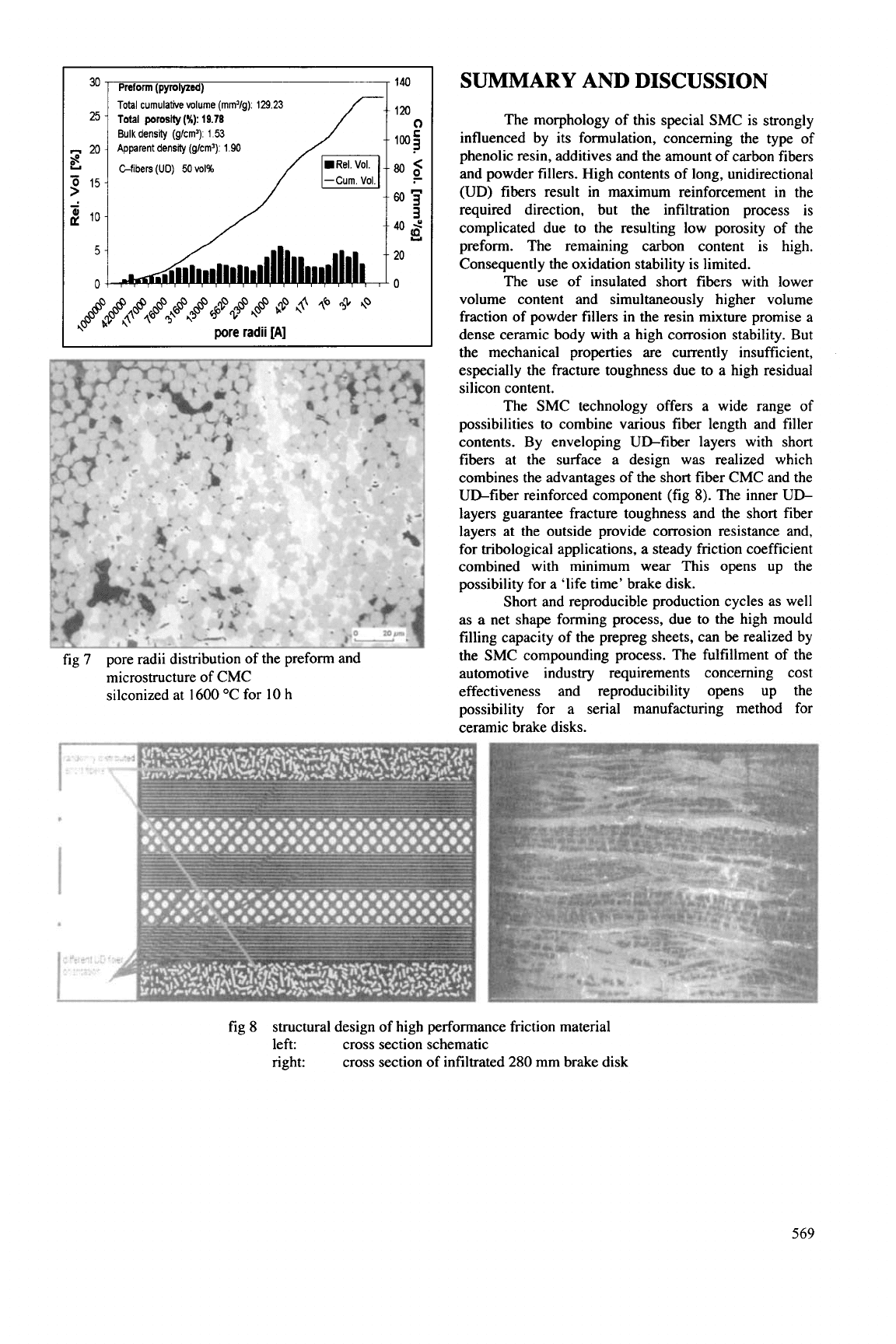
30
~
Preform
(pyro~ped)
140
Total
cumulative volume (mmVg): 129.23
25
Total
porosity
(X):
18.78
Bulk
density
(g/cm3): 1 53
c1
20
~
Apparent
densty
(glcm’): 1.90
E
C-fiben(UD)
50~01%
a
15-
>
-
p
io-
fig
7
pore radii distribution of the preform and
microstructure of CMC
silconized at
1600
“C for
10
h
SUMMARY AND DISCUSSION
The morphology of this special SMC is strongly
influenced by its formulation, concerning the type of
phenolic resin, additives and the amount of carbon fibers
and powder fillers. High contents of long, unidirectional
(UD) fibers result in maximum reinforcement
in
the
required direction, but the infiltration process is
complicated due to the resulting low porosity of the
preform. The remaining carbon content is high.
Consequently the oxidation stability is limited.
The use of insulated short fibers with lower
volume content and simultaneously higher volume
fraction of powder fillers in the resin mixture promise a
dense ceramic body with a high corrosion stability. But
the mechanical properties are currently insufficient,
especially the fracture toughness due to a high residual
silicon content.
The SMC technology offers a wide range of
possibilities to combine various fiber length and filler
contents. By enveloping UD-fiber layers with short
fibers at the surface a design was realized which
combines the advantages of the short fiber CMC and the
UD-fiber reinforced component (fig
8).
The inner
UD-
layers guarantee fracture toughness and the short fiber
layers at the outside provide corrosion resistance and,
for tribological applications, a steady friction coefficient
combined with minimum wear This opens up the
possibility for a ‘life time’ brake disk.
Short and reproducible production cycles as well
as a net shape forming process, due to the high mould
filling capacity of the prepreg sheets, can be realized by
the SMC compounding process. The fulfillment of the
automotive industry requirements concerning cost
effectiveness and reproducibility opens up the
possibility for a serial manufacturing method for
ceramic brake disks.
fig
8
structural design of high performance friction material
left: cross section schematic
right:
cross section of infiltrated
280
mm brake disk
569
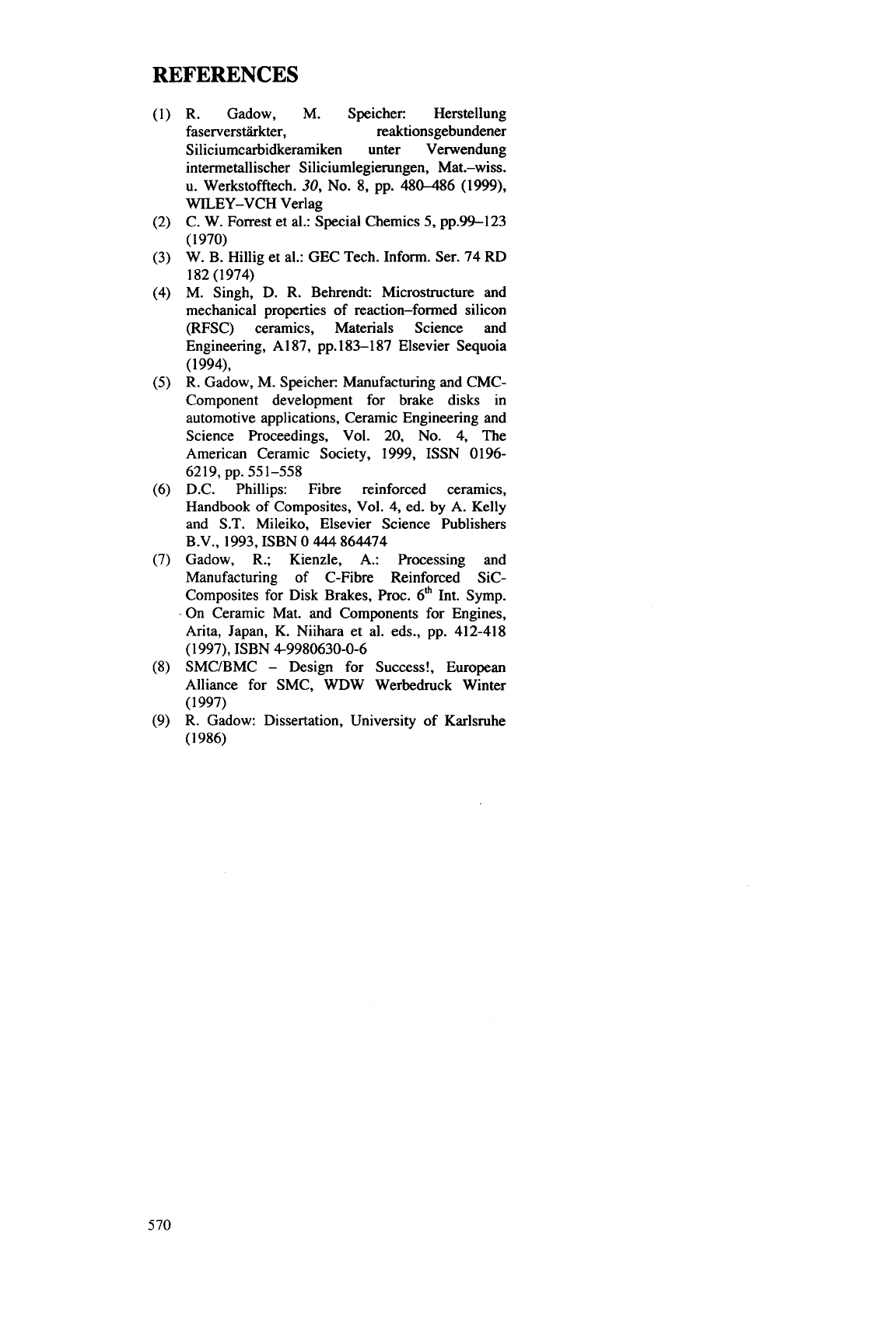
REFERENCES
R.
Gadow, M. Speicher: Herstellung
faserverstiirkter, reaktionsgebundener
Siliciumcarbidkeramiken unter Verwendung
intermetallischer Siliciumlegierungen, Mat.-wiss.
u.
Werkstofftech.
30,
No. 8, pp. 480-486 (1999),
WILEY-VCH Verlag
C. W. Forrest et al.: Special Chemics
5,
pp.99-123
(
1970)
W. B. Hillig et al.: GEC Tech. Inform. Ser. 74 RD
182 (1 974)
M. Singh, D.
R.
Behrendt: Microstructure and
mechanical properties of reaction-formed silicon
(RFSC) ceramics, Materials Science and
Engineering,
A1
87, pp. 183-1 87 Elsevier Sequoia
(19941,
R.
Gadow, M. Speicher: Manufacturing and CMC-
Component development for brake disks in
automotive applications, Ceramic Engineering and
Science Proceedings, Vol. 20, No. 4, The
American Ceramic Society, 1999, ISSN
01
96-
D.C. Phillips: Fibre reinforced ceramics,
Handbook of Composites, Vol. 4, ed.
by
A.
Kelly
and
S.T.
Mileiko, Elsevier Science Publishers
B.V., 1993, ISBN
0
444
864474
Gadow,
R.;
Kienzle,
A.:
Processing and
Manufacturing of C-Fibre Reinforced SiC-
Composites for Disk Brakes, Proc. 6" Int. Symp.
On Ceramic Mat. and Components for Engines,
Arita, Japan, K. Niihara et al. eds., pp. 412-418
SMC/BMC
-
Design for Success!, European
Alliance for SMC, WDW Werbedruck Winter
(
1997)
R.
Gadow: Dissertation, University of Karlsruhe
(1
986)
62
19, pp.
55
1-558
(1 997), ISBN 4-9980630-0-6
570
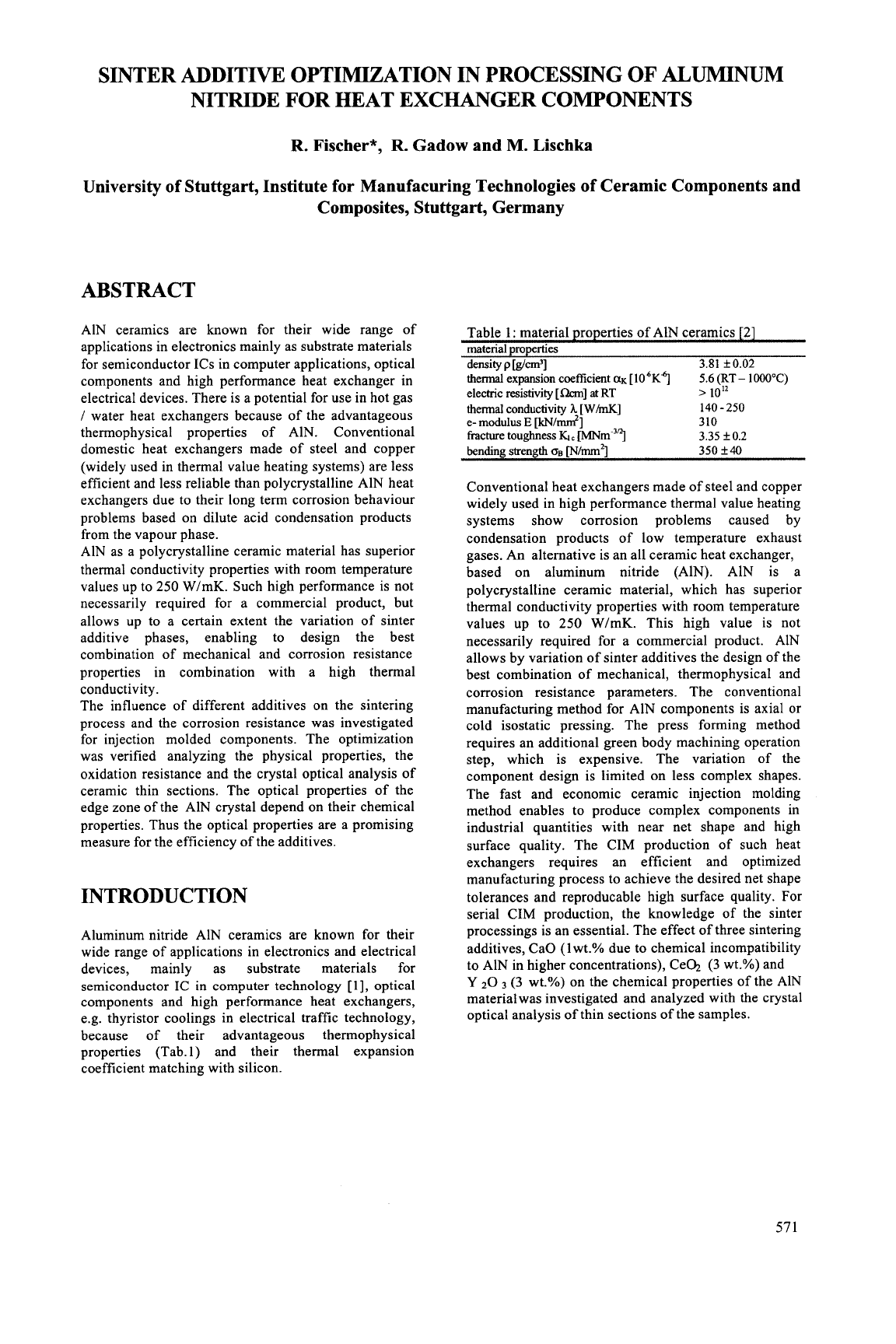
SINTER ADDITIVE OPTIMIZATION IN PROCESSING OF ALUMINUM
NITRIDE FOR HEAT EXCHANGER COMPONENTS
R.
Fischer*,
R.
Gadow and
M.
Lischka
University of Stuttgart, Institute for Manufacuring Technologies
of
Ceramic Components and
Composites, Stuttgart, Germany
ABSTRACT
AIN ceramics are known for their wide range of
applications in electronics mainly as substrate materials
for semiconductor ICs in computer applications, optical
components and high performance heat exchanger in
electrical devices. There is a potential for use in hot gas
I
water heat exchangers because of the advantageous
thermophysical properties of AlN. Conventional
domestic heat exchangers made of steel and copper
(widely used in thermal value heating systems) are less
efficient and less reliable than polycrystalline AlN heat
exchangers due to their long term corrosion behaviour
problems based on dilute acid condensation products
from the vapour phase.
AIN as a polycrystalline ceramic material has superior
thermal conductivity properties with room temperature
values up to
250
W/mK. Such high performance is not
necessarily required for a commercial product, but
allows up to a certain extent the variation of sinter
additive phases, enabling to design the best
combination of mechanical and corrosion resistance
properties in combination with a high thermal
conductivity.
The influence of different additives on the sintering
process and the corrosion resistance was investigated
for injection molded components. The optimization
was verified analyzing the physical properties, the
oxidation resistance and the crystal optical analysis of
ceramic thin sections. The optical properties of the
edge zone of the AlN crystal depend on their chemical
properties. Thus the optical properties are a promising
measure for the efficiency of the additives.
INTRODUCTION
Aluminum nitride A1N ceramics are known for their
wide range of applications in electronics and electrical
devices, mainly as substrate materials for
semiconductor
IC
in computer technology
[I],
optical
components and high performance heat exchangers,
e.g. thyristor coolings in electrical traffic technology,
because of their advantageous thermophysical
properties (Tab.
1)
and their thermal expansion
coefficient matching with silicon.
Table
1
:
material properties of A1N ceramics
[2]
material properties
density
p
[g/rm']
3.81
k0.02
thermal
expansion
coefficient
CXK
[106Kq
thermal
conductivity
h
[WhnKl
e-
modulus
E
[kN/nd]
310
bending strength
06
[~/mm']
Conventional heat exchangers made of steel and copper
widely used in high performance thermal value heating
systems show corrosion problems caused by
condensation products of low temperature exhaust
gases. An alternative is an all ceramic heat exchanger,
based on aluminum nitride (AIN). A1N is a
polycrystalline ceramic material, which has superior
thermal conductivity properties with room temperature
values up to
250
W/mK. This high value is not
necessarily required for a commercial product. A1N
allows by variation of sinter additives the design of the
best combination of mechanical, thermophysical and
corrosion resistance parameters. The conventional
manufacturing method for AIN components is axial
or
cold isostatic pressing. The press forming method
requires an additional green body machining operation
step, which is expensive. The variation of the
component design is limited on less complex shapes.
The fast and economic ceramic injection molding
method enables to produce complex components in
industrial quantities with near net shape and high
surface quality. The CIM production of such heat
exchangers requires an efficient and optimized
manufacturing process to achieve the desired net shape
tolerances and reproducable high surface quality. For
serial CIM production, the knowledge of the sinter
processings is an essential. The effect of three sintering
additives, CaO
(1
wt.% due to chemical incompatibility
to AIN in higher concentrations), Ce@
(3
wt.%) and
Y
2O
(3
wt.o/) on the chemical properties of the AIN
materialwas investigated and analyzed with the crystal
optical analysis of thin sections of the samples.
5.6
(RT-
lO00"C)
electric resistivity
[
h]
at
RT
fracture toughness
I<I
[~~rn.~'t]
>
10l2
140
-
250
3.35
f
0.2
350
f40
57
1
